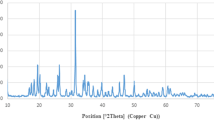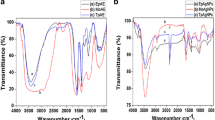Abstract
The most common disease among males diagnosed in the USA is prostate cancer, and managing it remains difficult in routine oncology practice. Therefore, people with prostate cancer demand improved therapeutic approaches. We effectively fabricated palladium, and ruthenium nanoparticles incorporated into core–shell Al2O3@SiO2@Fe3O4 (ASF) were effectively fabricated based on MOF MIL(Al)96. The fabricated nanoparticles were examined the various analytical and spectroscopic methods (FT-IR, UV–Vis, TEM, and SEM). The dynamic light scattering (DLS) method examined the particle size and stability of the nanoparticles. The cytotoxic efficiency of the nanoparticles was examined by in vitro against PC3pip and LNCAP human prostate cancer cells by MTT assay. Further, the fluorescence staining methods investigated the cells’ morphological changes and nuclear damage. The outcomes reveal that all fabricated nanoparticles will be potentially promising as anticancer agents for prostate cancer.










Similar content being viewed by others
Data availability
Data sharing does not apply to this article, as no data sets were generated or analyzed during the current study.
References
Zhang S, Sun K, Zheng R et al (2021) Cancer incidence and mortality in China, 2015. J Nat Cancer Cent 1:2–11. https://www.sciencedirect.com/science/article/pii/S2667005420300016
Qiu H, Cao S, Xu R (2021) Cancer incidence, mortality, and burden in China: a time-trend analysis and comparison with the United States and United Kingdom based on the global epidemiological data released in 2020. Cancer Commun. 41:1037–1048. https://doi.org/10.1002/cac2.12197
Huang Q, Zi H, Luo L et al (2022) Secular trends of morbidity and mortality of prostate, bladder, and kidney cancers in China, 1990 to 2019 and their predictions to 2030. BMC Cancer 22:1164. https://doi.org/10.1186/s12885-022-10244-9
Lee MM, Wang R-T, Hsing AW et al (1998) Case-control study of diet and prostate cancer in China. Cancer Causes Control 9:545–552. https://doi.org/10.1023/A:1008840105531
Jian L, Xie LP, Lee AH et al (2004) Protective effect of green tea against prostate cancer: a case-control study in southeast China. Int. J. Cancer 108:130–135. https://doi.org/10.1002/ijc.11550
Johannsen M, Gneveckow U, Taymoorian K et al (2007) Morbidity and quality of life during thermotherapy using magnetic nanoparticles in locally recurrent prostate cancer: results of a prospective phase I trial. Int. J. Hyperth. 23:315–323. https://doi.org/10.1080/02656730601175479
Thurn KT, Arora H, Paunesku T et al (2011) Endocytosis of titanium dioxide nanoparticles in prostate cancer PC-3M cells. Nanomedicine: Nanotechnology. Biol Med 7:123–130. https://www.sciencedirect.com/science/article/pii/S1549963410002996
Yeh C-Y, Hsiao J-K, Wang Y-P et al (2016) Peptide-conjugated nanoparticles for targeted imaging and therapy of prostate cancer. Biomaterials 99:1–15. https://www.sciencedirect.com/science/article/pii/S014296121630182X
Dreaden EC, Gryder BE, Austin LA et al (2012) Antiandrogen gold nanoparticles dual-target and overcome treatment resistance in hormone-insensitive prostate cancer cells. Bioconjug. Chem. 23:1507–1512. https://doi.org/10.1021/bc300158k
Gryparis EC, Hatziapostolou M, Papadimitriou E et al (2007) Anticancer activity of cisplatin-loaded PLGA-mPEG nanoparticles on LNCaP prostate cancer cells. Eur. J. Pharm. Biopharm. 67:1–8. https://www.sciencedirect.com/science/article/pii/S0939641106003833
Ghosh D, Lee Y, Thomas S et al (2012) M13-templated magnetic nanoparticles for targeted in vivo imaging of prostate cancer. Nat. Nanotechnol. 7:677–682. https://doi.org/10.1038/nnano.2012.146
Sahoo SK, Ma W (2004) Labhasetwar V. Efficacy of transferrin-conjugated paclitaxel-loaded nanoparticles in a murine model of prostate cancer. Int. J. Cancer 112:335–340. https://doi.org/10.1002/ijc.20405
Arnida Malugin A, Cellular Ghandehari H (2010) uptake and toxicity of gold nanoparticles in prostate cancer cells: a comparative study of rods and spheres. J. Appl. Toxicol. 30:212–217. https://doi.org/10.1002/jat.1486
Haribabu J, Srividya S, Mahendiran D et al (2020) Synthesis of palladium (II) complexes via Michael addition: antiproliferative effects through ROS-mediated mitochondrial apoptosis and docking with SARS-CoV-2. Inorg Chem 59:17109–17122
Swaminathan S, Haribabu J,Mohamed Subarkhan MK, et al (2022) Coordination behavior of acylthiourea ligands in their Ru(II)–benzene complexes─structures and anticancer activity. Organometallics 41:1621–1630
Swaminathan S, Haribabu J, Balakrishnan N et al (2022) Piano stool Ru(II)-arene complexes having three monodentate legs: a comprehensive review on their development as anticancer therapeutics over the past decade. Coord. Chem. Rev. 459:214403. https://www.sciencedirect.com/science/article/pii/S0010854521006779
Dorairaj DP, Haribabu J, Shashankh PVS et al (2022) Bidentate acylthiourea ligand anchored Pd-PPh3 complexes with biomolecular binding, cytotoxic, antioxidant and antihemolytic properties. J Inorg Biochem 233:111843
Singh S, Gill AAS, Nlooto M et al (2019) Prostate cancer biomarkers detection using nanoparticles based electrochemical biosensors. Biosens. Bioelectron. 137:213–221. https://www.sciencedirect.com/science/article/pii/S0956566319302441
Yallapu MM, Khan S, Maher DM et al (2014) Anti-cancer activity of curcumin loaded nanoparticles in prostate cancer. Biomaterials 35:8635–8648. https://www.sciencedirect.com/science/article/pii/S0142961214007467
Raju P, Balakrishnan K, Mishra M et al (2022) Fabrication of pH responsive FU@Eu-MOF nanoscale metal organic frameworks for lung cancer therapy. J. Drug Delivery Sci. Technol. 70:103223. https://www.sciencedirect.com/science/article/pii/S1773224722001332
Raju P, Natarajan S. Anticancer (2021) anti-biofilm and antimicrobial activity of fucoidan-loaded zeolitic imidazole framework fabricated by one-pot synthesis method. Appl. Nanosci. https://doi.org/10.1007/s13204-021-01881-w
Raju P, Ramalingam T, Nooruddin T et al (2020) In vitro assessment of antimicrobial, antibiofilm and larvicidal activities of bioactive nickel metal organic framework. J. Drug Delivery Sci. Technol. 56:101560. https://www.sciencedirect.com/science/article/pii/S1773224719317629
Raju P, Arivalagan P, Natarajan S (2020) One-pot fabrication of multifunctional catechin@ZIF-L nanocomposite: assessment of antibiofilm, larvicidal and photocatalytic activities. J. Photochem. Photobiol. B 203:111774. https://www.sciencedirect.com/science/article/pii/S1011134419314381
Yang X, Wei Q, Shao H et al (2019) Multivalent aminosaccharide-based gold nanoparticles as narrow-spectrum antibiotics in vivo. ACS Applied Materials & Interfaces 11:7725–7730. https://doi.org/10.1021/acsami.8b19658
Azerbaijan MH, Bahmani E, Jouybari MH et al (2021) Electrospun gold nanorods/graphene oxide loaded-core-shell nanofibers for local delivery of paclitaxel against lung cancer during photo-chemotherapy method. Eur. J. Pharm. Sci. 164:105914. https://www.sciencedirect.com/science/article/pii/S0928098721002153
Movahedi MM, Mehdizadeh A, Koosha F et al (2018) Investigating the photo-thermo-radiosensitization effects of folate-conjugated gold nanorods on KB nasopharyngeal carcinoma cells. Photodiagn. Photodyn. Ther. 24:324–331. https://www.sciencedirect.com/science/article/pii/S1572100018302394
Zhu M-Q, Wang L-Q, Exarhos GJ et al (2004) Thermosensitive gold nanoparticles. J. Am. Chem. Soc. 126:2656–2657. https://doi.org/10.1021/ja038544z
Sravani B, Kiranmai S, Rajasekhara Reddy G et al (2022) Highly sensitive detection of anti-cancer drug based on bimetallic reduced graphene oxide nanocomposite. Chemosphere 287:132281. https://www.sciencedirect.com/science/article/pii/S0045653521027533
Das P, Mudigunda SV, Darabdhara G et al (2020) Biocompatible functionalized AuPd bimetallic nanoparticles decorated on reduced graphene oxide sheets for photothermal therapy of targeted cancer cells. J. Photochem. Photobiol B 212:112028. https://www.sciencedirect.com/science/article/pii/S1011134420304784
Shmarakov I, Mukha I, Vityuk N et al (2017) Antitumor activity of alloy and core-shell-type bimetallic AgAu nanoparticles. Nanoscale Res. Lett. 12:333. https://doi.org/10.1186/s11671-017-2112-y
Darabdhara G, Das MR, Turcheniuk V et al (2015) Reduced graphene oxide nanosheets decorated with AuPd bimetallic nanoparticles: a multifunctional material for photothermal therapy of cancer cells. J. Mater. Chem. B 3:8366–8374. http://dx.doi.org/10.1039/C5TB01704A
Cao Y, Dhahad HA, El-Shorbagy MA et al (2021) Green synthesis of bimetallic ZnO–CuO nanoparticles and their cytotoxicity properties. Sci. Rep. 11:23479. https://doi.org/10.1038/s41598-021-02937-1
Rahmani R, Gharanfoli M, Gholamin M et al (2020) Plant-mediated synthesis of superparamagnetic iron oxide nanoparticles (SPIONs) using aloe vera and flaxseed extracts and evaluation of their cellular toxicities. Ceram. Int. 46:3051–3058. https://www.sciencedirect.com/science/article/pii/S0272884219328421
Andrés MA, Benzaqui M, Serre C et al (2018) Fabrication of ultrathin MIL-96(Al) films and study of CO2 adsorption/desorption processes using quartz crystal microbalance. J. Colloid Interface Sci. 519:88–96. https://www.sciencedirect.com/science/article/pii/S0021979718302066
Wang X, Zhu H, Sun T et al (2019) Synthesis and study of an efficient metal-organic framework adsorbent (MIL-96(Al)) for fluoride removal from water. J. Nanomater. 2019:3128179. https://doi.org/10.1155/2019/3128179
Zhou Y, Zeng HC (2016) Alumina-supported metal catalysts inside a mesoporous aluminum-silicate shell: nanoscale reactors prepared through the transformation of MIL-96(Al) nanocrystals. ChemCatChem 8:1283–1287. https://doi.org/10.1002/cctc.201600062
Wang Y, Jin J, Shu L et al (2020) New organometallic ruthenium(II) compounds synergistically show cytotoxic, antimetastatic and antiangiogenic activities for the treatment of metastatic cancer. Chem. Eur. J. 26:15170–15182. https://doi.org/10.1002/chem.202002970
Subarkhan MKM, Ramesh R (2016) Ruthenium(II) arene complexes containing benzhydrazone ligands: synthesis, structure and antiproliferative activity. Inorg. Chem. Front. 3:1245–1255
Kalaiarasi G, Mohamed Subarkhan M, Fathima Safwana CK et al (2022) Inorg. Chim. Acta 535:120863. https://www.sciencedirect.com/science/article/pii/S0020169322000755
Sathiya Kamatchi T, Mohamed Subarkhan MK, Ramesh R et al (2020) Investigation into antiproliferative activity and apoptosis mechanism of new arene Ru(ii) carbazole-based hydrazone complexes. Dalton Trans. 49:11385–11395. http://dx.doi.org/10.1039/D0DT01476A
Mohamed Subarkhan MK, Ramesh R, Liu Y (2016) Synthesis and molecular structure of arene ruthenium(II) benzhydrazone complexes: impact of substitution at the chelating ligand and arene moiety on antiproliferative activity. New Journal of Chemistry 40.
Giriraj K, Mohamed Kasim MS, Balasubramaniam K et al (2022) Various coordination modes of new coumarin Schiff bases toward Cobalt (III) ion: synthesis, spectral characterization, in vitro cytotoxic activity, and investigation of apoptosis. Appl. Organomet. Chem. 36:e6536. https://doi.org/10.1002/aoc.6536
Mohamed Kasim MS, Sundar S, Rengan R (2018) Synthesis and structure of new binuclear ruthenium(II) arene benzil bis(benzoylhydrazone) complexes: investigation on antiproliferative activity and apoptosis induction. Inorg. Chem. Front. 5:585–596
Mohan N, Mohamed Subarkhan MK, Ramesh R (2018) Synthesis, antiproliferative activity and apoptosis-promoting effects of arene ruthenium(II) complexes with N, O chelating ligands. Journal of Organometallic Chemistry.859
Balaji S, Mohamed Subarkhan MK, Ramesh R et al (2020) Synthesis and structure of arene Ru(II) N∧O-chelating complexes: in vitro cytotoxicity and cancer cell death mechanism. Organometallics 39:1366–1375. https://doi.org/10.1021/acs.organomet.0c00092
Swaminathan S, Haribabu J, Mohamed Subarkhan MK et al (2021) Impact of aliphatic acyl and aromatic thioamide substituents on the anticancer activity of Ru(ii)-p-cymene complexes with acylthiourea ligands—in vitro and in vivo studies. Dalton Trans. 50:16311–16325. http://dx.doi.org/10.1039/D1DT02611A
Pilliadugula R, Haribabu J (2021) Mohamed Subarkhan MK, et al. Effect of morphology and (Sn, Cr) doping on in vitro antiproliferation properties of hydrothermally synthesized 1D GaOOH nanostructures. Journal of Science: Advanced Materials and Devices 6:351–363. https://www.sciencedirect.com/science/article/pii/S2468217921000174
Liu K, Liu P, Liu R et al (2015) Dual AO/EB staining to detect apoptosis in osteosarcoma cells compared with flow cytometry. Med. Sci. Monit. Basic Res. 21:15–20. https://www.ncbi.nlm.nih.gov/pubmed/25664686
Kasibhatla S, Amarante-Mendes GP, Finucane D, et al. (2006) Acridine orange/ethidium bromide (AO/EB) staining to detect apoptosis [Internet]. CSH protocols 799–803. http://europepmc.org/abstract/MED/22485874
Fischer D, Li Y, Ahlemeyer B et al (2003) In vitro cytotoxicity testing of polycations: influence of polymer structure on cell viability and hemolysis. Biomaterials 24:1121–1131. http://www.sciencedirect.com/science/article/pii/S0142961202004453
Wang W, Dong X, Liu Y et al (2020) Itraconazole exerts anti-liver cancer potential through the Wnt, PI3K/AKT/mTOR, and ROS pathways. Biomed. Pharmacother. 131:110661. https://www.sciencedirect.com/science/article/pii/S0753332220308544
Haribabu J, Garisetti V, Malekshah RE et al (2022) Design and synthesis of heterocyclic azole based bioactive compounds: molecular structures, quantum simulation, and mechanistic studies through docking as multi-target inhibitors of SARS-CoV-2 and cytotoxicity. J Mol Struct 1250:131782
Haribabu J, Balakrishnan N, Swaminathan S et al (2021) Synthesis, cytotoxicity and docking studies (with SARS-CoV-2) of water-soluble binuclear Ru-p-cymene complex holding indole thiosemicarbazone ligand. Inorg. Chem. Commun. 134:109029. https://www.sciencedirect.com/science/article/pii/S1387700321005840
Huang J, Jia Z, Liang Y et al (2020) Pulse electromagnetic fields enhance the repair of rabbit articular cartilage defects with magnetic nano-hydrogel. RSC Advances 10:541–550. http://dx.doi.org/10.1039/C9RA07874F
Author information
Authors and Affiliations
Corresponding author
Ethics declarations
Conflict of interest
The authors declare no competing interests.
Additional information
Publisher's note
Springer Nature remains neutral with regard to jurisdictional claims in published maps and institutional affiliations.
Rights and permissions
Springer Nature or its licensor (e.g. a society or other partner) holds exclusive rights to this article under a publishing agreement with the author(s) or other rightsholder(s); author self-archiving of the accepted manuscript version of this article is solely governed by the terms of such publishing agreement and applicable law.
About this article
Cite this article
Sun, Y., Yu, S., Liu, J. et al. Facile fabrication of palladium and ruthenium nanoparticles incorporated into core–shell: investigation of proliferation and apoptosis induction in prostate cancer cells. J Nanopart Res 25, 91 (2023). https://doi.org/10.1007/s11051-023-05732-3
Received:
Accepted:
Published:
DOI: https://doi.org/10.1007/s11051-023-05732-3




